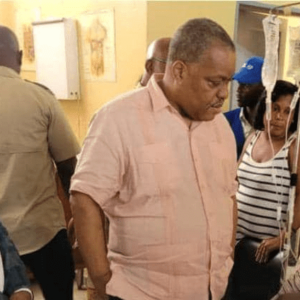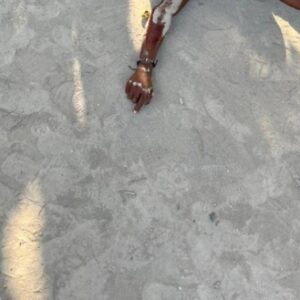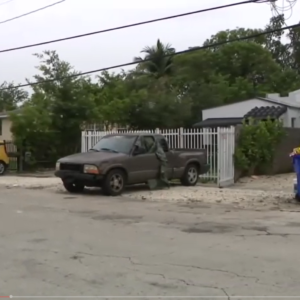By Marcelin Montaigne
A first delegation made up of around fifty Kenyans arrived in Port au Prince this Monday, other larger groups will follow this week
What collaboration will financial institutions in Haiti offer to the Mission theoretically led by Kenya in this fight against the activities of armed criminal gangs and in sensitive areas such as Monitoring and regulation and the Information sharing?
For many observers, behind the Kenyan government’s pan-Africanist rhetoric lies what will soon appear to be subjugation direct control of the Haitian population in the hands of the Kenyan state, aided and abetted by the United States.
What shock should players in the banking sector in Haiti expect in the fight against armed criminal gangs?
Note that for the Regulator of the banking sector in Haiti, the Bank of the Republic of Haiti (BRH), the economic literature distinguishes four types of shocks:
• temporary shocks and permanent shocks,
• country-specific shocks and sector-specific shocks,
• real shocks and financial shocks,
• exogenous shocks and policy-induced shocks
According to the latest BRH publication, Research Paper No. 6, dated May 2024 temporary shocks can be corrected by cyclical changes in fiscal and/or monetary policy, or by borrowing.
On the other hand, permanent shocks can generally only be absorbed by drop in income and comparative real prices, by the emigration of labor, or by a profound long-term restructuring, notes the Banking Regulator in its Research Paper.
This distinction, considers the BRH, is important if only because any confusion between these two types of shocks risks encouraging measures that worsen the situation instead of improving it.
In particular, treating shocks with a permanent and structural effect as if they were temporary shocks would only serve to reinforce the underlying loss of competitiveness and make the necessary reform more difficult.
The BRH, boss of the banking sector, did not consider it useful to qualify the “shock” that the Haitian population is experiencing with the presence of armed criminal gangs in the four corners of the metropolitan area of Port-au-Prince, even if it considers that the security situation deteriorated sharply and quickly from the first quarter of 2020 and that the assassination of the President of the Republic on July 7, 2021 Jovenel Moïse, aggravated the political and institutional crisis, thus fueling expectations negative, reinforcing the negative perception of Haiti among investors and increasing country risk.
In her research, she also did not make even a partial assessment of the damage caused in the said sector by the activities of the armed forces. Barbecue, two Izo-5 Seconds, Jeff Canaan, Death 100 Days in the City Center, in Bon Repos, in Croix -des-Bouquets, …. Etc.
However, engaged in the Stabilization and Security Mission in Haiti authorized by the United Nations Security Council, the first elements of the Kenyan force, Kenyan police officers landed in Port au Prince this Monday, May 20.
We present in the following the experience of the collaboration of Kenyan force with the banking sector of Somalia in the fight against the terrorist group Al-Shabaab as well as the difficulties encountered
COLLABORATION OF THE KENYA FORCE WITH THE LASOMALIA BANKING SECTOR Kenya is collaborating with the banking sector in Somalia in the fight against the terrorist group Al-Shabaab in several strategic and operational ways:
Monitoring and regulation
Kenya is working with Somali financial institutions to strengthen supervisory and regulatory measures. This includes monitoring suspicious transactions and implementing rigorous controls to prevent terrorist financing. Somali banks are encouraged to report suspicious financial activity to Kenyan and international authorities.
Concrete Actions:
– Strengthening compliance standards: Somali banks, with support from Kenya, are adopting stricter compliance standards to monitor suspicious transactions. This includes the use of sophisticated financial monitoring software.
– Collaboration with regulatory agencies: Kenyan and Somali authorities are working with entities such as the Central Bank of Somalia to strengthen anti-money laundering and counter-terrorist financing (AML/CFT) policies.
Examples:
– Interbank Working Group: An interbank working group comprising representatives from Kenyan and Somali banks meets regularly to discuss terrorism financing trends and techniques, enabling better coordination and response.
Information Sharing
Kenyan intelligence services work closely with their Somali counterparts to exchange information on Al-Shabaab’s financing networks. This sharing of intelligence makes it possible to identify and dismantle the terrorist group’s sources of financing.
Concrete Actions
– Regular exchanges of information: Kenyan and Somali intelligence agencies regularly share information on suspicious financial transactions and the activities of terrorist networks.
– Secure information sharing platforms: Establishment of secure platforms for real-time sharing of financial information between the two countries.
Examples:
– Joint operations: In 2019, a joint operation between Kenya and Somalia dismantled an Al-Shabaab financing network, involving the seizure of funds and the arrest of key suspects through information sharing.
Training and capacity building:
Kenya is helping train Somali banking staff to recognize money laundering and terrorism financing schemes. Capacity building programs are implemented to improve the compliance and counter-terrorism financing skills of bank employees.
Concrete Actions:
– Specialized training programs: Organizing training seminars and workshops for staff of Somali banks on money laundering and terrorist financing detection techniques.
– Partnerships with international experts: Collaboration with experts from the UN and other international organizations to provide advanced training and educational resources.
Examples:
– Compliance team training: In 2021, training sessions were held in Nairobi, where Somali bank employees were trained by Kenyan and international experts on AML/CFT best practices.
Regional and international cooperation:
Kenya is part of various regional and international forums, such as the Intergovernmental Authority on Development (IGAD) and the African Union (AU), where joint strategies are developed to combat Al-Shabaab. Cooperation also includes partnerships with international agencies such as the UN and the FATF (Financial Action Task Force).
Concrete Actions:
– Participation in regional forums: Kenya and Somalia actively participate in forums such as the Intergovernmental Authority on Development (IGAD) to coordinate their efforts to combat the financing of terrorism.
– Bilateral cooperation agreements: Signing of specific bilateral cooperation agreements between the two countries to facilitate cross-border investigations and prosecutions.
Examples:
– Regional Financial Security Summit:a In 2020, a regional summit in Addis Ababa brought together representatives of central banks and regulatory authorities from Kenya, Somalia and other countries in the region to discuss strategies for fight against the financing of terrorism.
Legislative and policy initiatives
Kenya and Somalia are working together to align their legislative and policy frameworks on countering the financing of terrorism. This harmonization facilitates the application of laws and regulations across borders.
These combined efforts aim to dry up Al-Shabaab’s funding sources, making it more difficult for the group to carry out terrorist operations and recruit new members.
Concrete Actions:
– Harmonization of laws: Joint work to align the national laws of the two countries regarding the financing of terrorism, thus facilitating consistent application of the laws.
– Banking Policy Updates: Regular reviews of banking policies to ensure they respond to current and future threats posed by Al-Shabaab.
Examples:
– Adoption of new legislation: In 2018, Somalia adopted a new anti-money laundering law with technical assistance from Kenya, strengthening the legal framework to combat the financing of terrorism.
Of course, here is a detailed presentation of the five points raised with concrete actions and supporting examples:
DIFFICULTIES IN ITS COLLABORATION WITH THE BANKING SECTOR Kenya faces several difficulties in its collaboration with Somalia’s banking sector to combat the terrorist group Al-Shabaab. Here are some of the main difficulties:
Weak Financial Infrastructure
Details :
– Lack of banking infrastructure: Due to decades of conflict, Somalia has limited banking infrastructure, making it difficult to effectively implement counter-terrorism financing measures.
– Use of informal systems: A large part of financial transactions in Somalia are done through informal systems like hawalas, which are more difficult to monitor and regulate.
Examples:
-Low presence of formal banks: The limited number of formal banks in Somalia makes it difficult to monitor financial flows and implement AML/CFT policies.
Limited Technical Capabilities and Resources
Details :
– Lack of trained staff: The Somali banking sector lacks trained staff in compliance and suspicious transaction detection.
– Insufficient resources: Somali banks often lack the resources to invest in advanced financial surveillance technologies.
Examples:
– Insufficient training sessions: Despite training efforts, the coverage and frequency of these sessions remain insufficient to create a significant long-term impact.
Corruption and Governance
Details :
– Widespread corruption: Corruption within Somali institutions, including in the banking sector, complicates the implementation of measures to combat the financing of terrorism.
– Governance problems ce: Weaknesses in governance and the rule of law in Somalia reduce the effectiveness of financial regulations.
Examples:
– Embezzlement: Cases of embezzlement and corruption within Somali banks weaken oversight and regulatory efforts.
Security Threats
Details :
– Terrorist attacks: Somali banks are often targets of attacks by Al-Shabaab, endangering employees and complicating normal banking operations.
– Regional instability: Continued instability in parts of Somalia makes it difficult to implement collaboration and training initiatives.
Examples:
– Branch closures: Some banks have had to close branches in high-risk areas due to direct terrorist threats.
International Cooperation Limited
Details :
– International Sanctions: Somalia faces international sanctions that complicate cross-border financial transactions and limit access to international financial markets.
– Distrust and isolation: The international community’s distrust of the Somali financial sector limits cooperation and information sharing.
Examples:
– Restrictions on transactions: Restrictions imposed by Western countries and financial sanctions limit the ability of Somali banks to fully collaborate with international financial institutions.
These difficulties demonstrate the many challenges that Kenya must overcome in working with the Somali banking sector to effectively combat Al-Shabaab financing.








